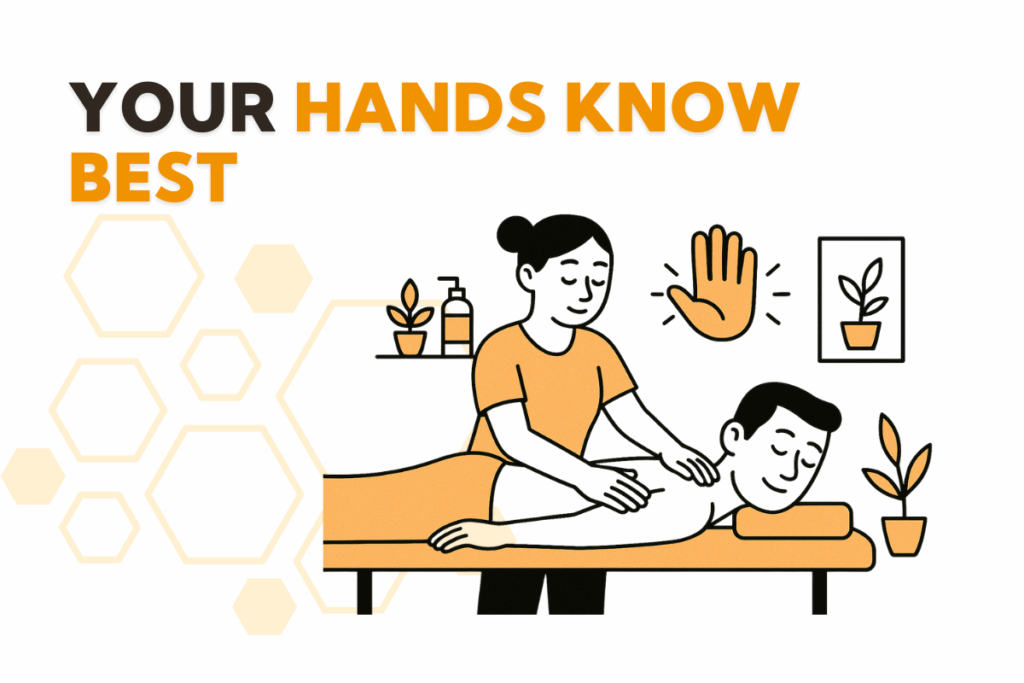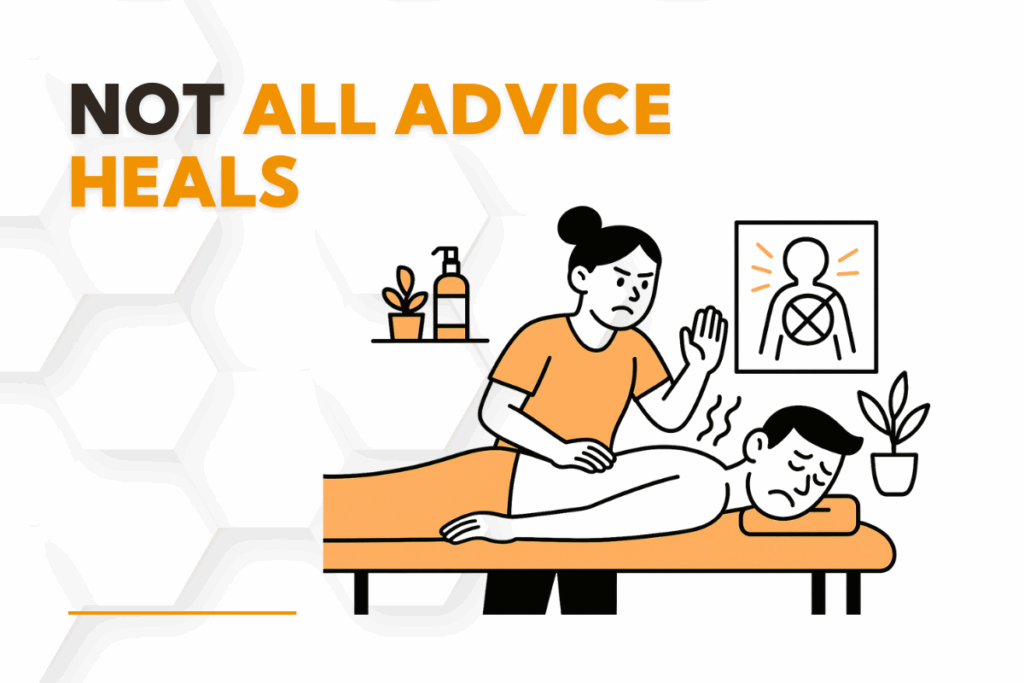Undoing generic advice from clients is one of the most frustrating and time-consuming challenges massage therapists face today. Whether it’s a trending stretch from TikTok or a self-diagnosed “joint misalignment” found in a blog, these unsolicited ideas often arrive at your table before the session even begins. You’re not just managing tissue—you’re managing expectations shaped by social media algorithms.
Misinformation Walks In Before the Client Even Speaks
Your Expertise Is Being Challenged Before You Begin
When a client questions your treatment plan because of something they read online, it doesn’t always come from a place of distrust—it often comes from confusion or desperation. Still, undoing generic advice during a session takes a toll. It delays your ability to begin effective treatment, forces you into a defensive role, and changes the dynamic of the session from collaborative to cautious.
The Cost of Correcting Online Misinformation
These moments chip away at your emotional energy. Ten minutes spent explaining why a TikTok drill doesn’t apply to their chronic hip pain means ten minutes less hands-on care. Over time, this cycle adds up—not just in lost income or reduced results, but in the erosion of trust between you and your clients. It’s not just inconvenient—it’s disruptive to both progress and professionalism.
Why Clients Trust Generic Advice More Than They Realize
Fast Information Feels More Certain
Generic advice works because it’s emotionally satisfying. The people sharing it appear confident. The instructions are easy to follow. The outcomes seem universal. That simplicity appeals to clients who are overwhelmed or stuck in pain. Unfortunately, what’s presented as a “quick fix” rarely accounts for individual differences in posture, activity level, or underlying causes.
They Don’t Always Understand the Depth of Your Process
Most therapists don’t market themselves like influencers. You don’t post every session or explain every step. So when a client sees you doing quiet, thoughtful work, it may appear to them like less is happening—even though the truth is the opposite. Undoing generic advice becomes more difficult when the value of your nuanced, personalized approach isn’t visible on the surface.

When You Spend More Time Explaining Than Treating
Sessions Shift From Healing to Convincing
Instead of starting with assessment, you’re starting with skepticism. The focus shifts to justifying your method, which interferes with the connection and the session’s flow. Undoing generic advice becomes the unplanned first task of every treatment.
Treatment Time Gets Squeezed
It’s not uncommon to spend a quarter of the session educating a client about why their YouTube warm-up didn’t help. These are minutes you don’t get back, and neither does the client. Both of you lose value when misinformation dominates the conversation.
Progress Is Undermined Between Sessions
If a client chooses to follow that generic advice at home instead of your plan, it can slow or reverse their progress. You end up troubleshooting problems that didn’t exist before, making your work harder and less effective.
Grounded Communication That Rebuilds Trust
Curiosity Is More Effective Than Correction
When a client shares something they saw online, start by asking why it appealed to them. This uncovers their actual concern—whether it’s fear, urgency, or confusion—and gives you space to validate their effort while gently redirecting it toward a more appropriate plan. Undoing generic advice becomes less about confrontation and more about re-alignment.
Reaffirm the Partnership
Clients want to feel involved in their care. Acknowledge that they’re trying. Let them know you’re on the same team. When you respond with calm authority and a personalized explanation, they’re more likely to re-engage with your treatment plan—even if it means abandoning the advice they brought in.
Use the Body as the Evidence
Rather than debating the post, guide the client to notice how their body responds in the moment. Give them space to compare what they read with what they feel. Undoing generic advice often works best when they experience the difference firsthand.
Protect Your Energy While Guiding the Session
Shape the Session With Gentle Boundaries
You can listen without letting the misinformation dominate the time. If needed, set a limit by suggesting, “Let’s explore this together, but I want to make sure we have time for your treatment.” This reframes the session and puts your care back at the center.
Keep Communication Flowing After the Session
Use email and text reminders for massage therapy clients to reinforce the plan and help reduce confusion between visits. A simple, confident message reminding them of your recommended exercises or expected sensations can stop the scroll before it starts.
Give Clients Reliable Touchpoints Between Sessions
Help clients avoid falling back into generic online routines by offering tailored check-ins or resources through online intake forms for post-session care. When they have your input easily accessible, they’re less likely to seek guidance elsewhere.

Building Loyalty Through Thoughtful Guidance
Results Speak Louder Than Posts
Undoing generic advice might not feel rewarding in the moment, but over time, your consistent, skilled support becomes the anchor clients trust. When they feel better because of your care—not despite it—they begin to tune out the noise.
Your Calm Confidence Sets You Apart
You don’t need to match the energy of viral content. You just need to stay grounded in your knowledge, clear in your boundaries, and consistent in your delivery. This creates a reliable, reassuring presence in a world of mixed messages.
Every Time You Clarify, You Deepen Trust
You’re not just undoing generic advice—you’re restoring a therapeutic environment that honors real progress. Clients may walk in with ideas from someone else’s body, but they leave feeling more connected to their own. The more you reinforce that clarity with compassion, the more your practice becomes a place clients return to—not just for relief, but for trust they can count on.
FAQs
Stay calm and ask what drew them to that suggestion. Once they feel heard, explain how your personalized plan addresses their specific needs more effectively.
Yes. When done with empathy, it builds trust. Clients begin to see you as a reliable guide who cares about their whole journey, not just the session.
Only if it aligns with your strengths. Even simple educational posts or thoughtful responses to common issues can establish your credibility and redirect clients to evidence-based care.
Use automated reminders, tailored aftercare, and confident communication to keep clients aligned. When they see results from your plan, they’re more likely to trust your guidance next time.


